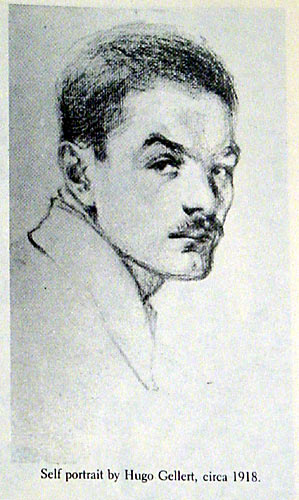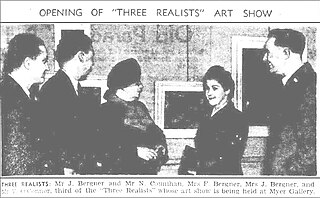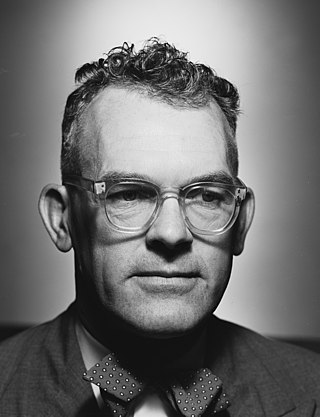Herbert McClintock (1906-1985) was an Australian social realist artist.
Contents
Born: 1906, Perth, Australia
Died: 1985 (age 79 years)
Herbert McClintock (1906-1985) was an Australian social realist artist.
Born: 1906, Perth, Australia
Died: 1985 (age 79 years)
McClintock was born in Perth, Western Australia. He studied at the National Gallery of Victoria Art School from 1925 to 1927 and again in 1930, where he met fellow social realists Noel Counihan and Roy Dalgarno. While a student, McClintock earned a living as a signwriter and advertising artist. He joined the Communist Party of Australia during the depression of the 1930s and did many political cartoons for communist publications. His cartoons were featured in trade union and communist papers throughout his life.

Socialist realism was the official cultural doctrine of the Soviet Union that mandated an idealized representation of life under socialism in literature and the visual arts. The doctrine was first proclaimed by the First Congress of Soviet Writers in 1934 as approved method for Soviet cultural production in all media. Following World War II, socialist realism was adopted by countries politically aligned with the Soviet Union. The primary official objective of socialist realism was "to depict reality in its revolutionary development" although no formal guidelines concerning style or subject matter were provided.

Social realism is the term used for work produced by painters, printmakers, photographers, writers and filmmakers that aims to draw attention to the real socio-political conditions of the working class as a means to critique the power structures behind these conditions. While the movement's characteristics vary from nation to nation, it almost always uses a form of descriptive or critical realism.

Noel Counihan was an Australian social realist painter, printmaker, cartoonist and illustrator active in the 1940s and 1950s in Melbourne. An atheist, communist, and art activist, Counihan made art in response to the politics and social hardships of his times. He is regarded as one of Australia's major artists of the 20th century.
Frederick Leslie Roy Dalgarno was an Australian social realist artist.
McClintock is a surname of Scottish and Irish Gaelic origin deriving from an anglicization of a Gaelic name variously recorded as M'Ilandick, M'Illandag, M'Illandick, M'Lentick, McGellentak, Macilluntud, McClintoun, and Mac Illiuntaig from the 14th century onward. The name is found mostly in County Donegal. The surname "McClinton" is an anglicization of the same Gaelic name. Notable people with the surname include:

Albert Lee Tucker was an Australian artist and member of the Heide Circle, a group of modernist artists and writers associated with Heide, the Melbourne home of art patrons John and Sunday Reed. Along with Heide Circle members such as Sidney Nolan and Arthur Boyd, Tucker became associated with the Angry Penguins art movement, named after a publication founded by poet Max Harris and published by the Reeds.

William Henry ('Will') Dyson was an Australian illustrator, artist and political cartoonist who achieved international recognition. He initially worked as a freelance artist in Australia, developing a specialty as a caricaturist, notably in The Bulletin magazine. In 1909 Dyson married Ruby Lindsay and the couple settled in London soon afterwards. As cartoonist for The Daily Herald newspaper, Dyson became widely known as an illustrator and commentator supporting progressive social reforms in Britain. His cartoons were often controversial, tackling difficult issues such as poverty, inequality and war, and were characterised by their biting wit and artistic impact. At the outbreak of World War I Dyson directed his scathing artwork at German militarism. In 1916 he applied to join the Australian forces at the Western Front as an artist. He was appointed an honorary lieutenant and joined the Anzac troops in France in January 1917. By the following May his appointment as Australia's first official war artist was formalised. After the death of his wife in March 1919 Dyson went through a difficult emotional period, during which his artistic output suffered. In late 1924 he returned to Australia after accepting a contract to work for the Herald publishing group in Melbourne. Dyson returned to England in 1930. He died in London in 1938, aged 57.

Stanley George Cross was born in the United States but was known as an Australian strip and political cartoonist who drew for Smith's Weekly and the Herald & Weekly Times. Cross is famous for his iconic 1933 "For gorsake, stop laughing: this is serious!” cartoon as well as the Wally and the Major and The Potts cartoon strips.

Cecilia May Gibbs MBE was an Australian children's author, illustrator, and cartoonist. She is best known for her gumnut babies, and the book Snugglepot and Cuddlepie.

Hugo Gellert was a Hungarian-American illustrator and muralist. A committed radical and member of the Communist Party of America, Gellert created much work for political activism in the 1920s and 1930s. It was distinctive in style, considered by some art critics as among the best political work of the first half of the 20th century.
James Edward Buchanan Boswell was a New Zealand-born British painter, draughtsman and socialist.

Socialist realism in Poland was a socio-political and aesthetic doctrine enforced by the pro-Soviet communist government in the process of Stalinization of the post-war Polish People’s Republic. The official policy was introduced in 1949 by a decree of the Polish United Workers' Party minister Włodzimierz Sokorski. As in all Soviet-dominated Eastern Bloc countries, Socialist realism became the main instrument of political control in the building of totalitarianism in Poland. However, the trend never became truly dominant. Following Stalin's death, and especially from 1953 on, critical opinions were heard with increasing frequency. Finally, as part of the Gomułka political thaw from within the Polish United Workers' Party, the entire doctrine was officially given up in 1956. Following Bierut's death on March 12, 1956, and the subsequent De-Stalinization of all People's Republics, Polish artists, writers and architects started abandoning it around 1956.

Victor George O'Connor was an Australian artist and an exponent of the principles of social realist art. From the time of the Great Depression in the 1930s his work embodied social and political comment on the conditions of working-class people and the structures of society that caused their suffering.
Louis Leon Ribak was an American social realist and abstract painter who was a member of the "Taos Moderns" group of artists.

Jacob Burck was a Polish-born Jewish-American painter, sculptor, and award-winning editorial cartoonist. Active in the Communist movement from 1926 as a political cartoonist and muralist, Burck quit the Communist Party after a visit to the Soviet Union in 1936, deeply offended by political demands there to manipulate his work.

Harold "Hal" Missingham AO was an Australian artist, Director of the Art Gallery of New South Wales from 1945 to 1971, and president of the Australian Watercolour Institute from 1952 to 1955.

Realism was an artistic movement that emerged in France in the 1840s, around the 1848 Revolution. Realists rejected Romanticism, which had dominated French literature and art since the early 19th century. Realism revolted against the exotic subject matter and the exaggerated emotionalism and drama of the Romantic movement. Instead, it sought to portray real and typical contemporary people and situations with truth and accuracy, and not avoiding unpleasant or sordid aspects of life. The movement aimed to focus on unidealized subjects and events that were previously rejected in art work. Realist works depicted people of all classes in situations that arise in ordinary life, and often reflected the changes brought by the Industrial and Commercial Revolutions. Realism was primarily concerned with how things appeared to the eye, rather than containing ideal representations of the world. The popularity of such "realistic" works grew with the introduction of photography—a new visual source that created a desire for people to produce representations which look objectively real.
James Budd Dixon was an American Abstract Expressionist painter and printmaker. He was a member of the "Sausalito Six" group of San Francisco Bay Area painters.
Julie Dowling is an Indigenous Australian artist whose work, in a social realist style, deals with issues of Aboriginal identity. She identifies culturally and politically as a Badimaya First Nation woman.

Dorothy Eisner (1906–1984) was an American artist whose painting style evolved over many years from an early, quite personal, version of 1930s social realism, through a period of abstract expressionism, and culminating over the last twenty years of her life in a bright painterly style that critics saw as fluid, masterfully composed, and expressionistic. Throughout her long career Eisner maintained a consistency that a gallerist summarized as derived from European modernism but also grounded in American painting of her own generation and the generation before her. Born and raised in Manhattan, she traveled widely and is best known for the late work she made while staying in a summer home off the coast of Maine on Great Cranberry Island.